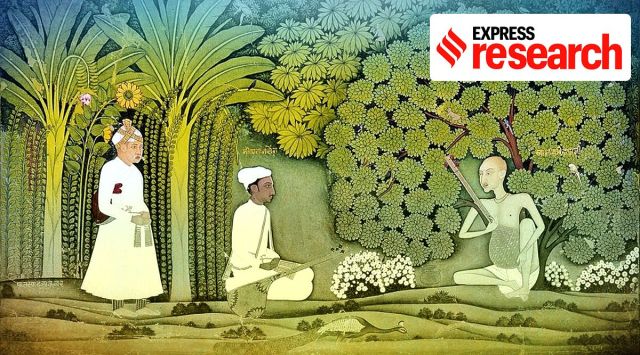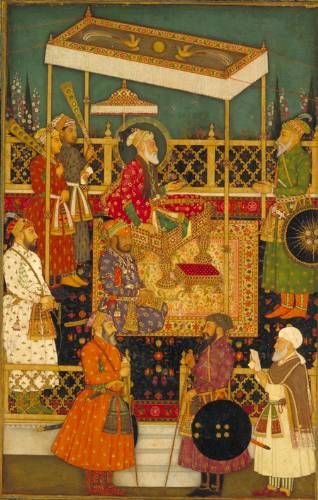- India
- International
Gharanas, the anchor of Hindustani music spawned by Mughal decline
The origin of the gharana tradition is traced back to the time when the Mughal empire was at its twilight, and art and culture of the court, disintegrated to find new homes in the princely states.
 The gharana system of Hindustani classical music, though steeped as it would appear, in tradition, is barely two or three centuries old. (Wikimedia Commons)
The gharana system of Hindustani classical music, though steeped as it would appear, in tradition, is barely two or three centuries old. (Wikimedia Commons)Bandish Bandits, a new Amazon Prime web series directed by Anand Tiwari, has opened up conversations around the tradition and discipline of Hindustani classical music and the kind of possibilities it creates upon fusing with more contemporary styles.
The series, while introducing millenials to the nuances of Hindustani classical music, also pours light on the politics of classical music in north India, in particular that of the gharana tradition. ‘Gharana’, derived from the Hindi word ‘ghar’ (house), is a system by which a certain style of music, unique to the particular unit, is handed down from teacher to disciple. For the longest time, a gharana consisted strictly of family members and music was preserved within its lineage, almost like any other property.
 The series, while introducing millenials to the nuances of Hindustani classical music, also pours light on the politics of classical music in north India.
The series, while introducing millenials to the nuances of Hindustani classical music, also pours light on the politics of classical music in north India.
Interestingly, the gharana system of Hindustani classical music, though steeped as it would appear, in tradition, is barely two or three centuries old. Its origin is traced back to the time when the Mughal empire was at its twilight, and art and culture of the court, disintegrated to find new homes in the princely states.
Decline of the Mughal empire and emergence of gharanas
A crucial moment in the history of music in the Mughal empire was in 1668-69 when emperor Aurangzeb ordered a ban on music. Italian traveler Niccolai Manucci, who documented the event, wrote about a “great destruction in musical instruments”: “If any house or elsewhere he heard the sound of singing and instruments, he should forthwith hasten there and arrest as many as he could, breaking the instruments.”
Traditionally historians have understood this ban as being uncompromisingly enforced, and a mark of Aurangzeb’s orthodox and repressive tendencies. More recent scholarship, however, has noted that the ban on music by Aurangzeb was perhaps just restricted to his court, even as it flourished in the provinces and under the patronage of Mughal nobles in Delhi.
 A crucial moment in the history of music in the Mughal empire was in 1668-69 when emperor Aurangzeb ordered a ban on music. (Wikimedia Commons)
A crucial moment in the history of music in the Mughal empire was in 1668-69 when emperor Aurangzeb ordered a ban on music. (Wikimedia Commons)Historian Katherine Butler Brown, in her article ‘Did Aurangzeb ban music?’, explains that the decision to ban music was primarily due to personal reasons of grief and religious piety. However, she maintains that there was no dearth of music patrons to make up for the loss of employment caused by Aurangzeb’s ban. “Several paintings, for example, produced between 1680-1710 at the court of Udaipur depict musicians performing for Maharana Jai Singh and Maharana Amar Singh,” writes Brown, adding names of several other such patrons both in Delhi and in the provinces.

A crucial moment in the history of music in the Mughal empire was in 1668-69 when emperor Aurangzeb ordered a ban on music. (Wikimedia Commons)
In the decades following the death of Aurangzeb, a line of incapable rulers, a factitious nobility, and a number of agrarian uprisings had strained the resources of the empire. Soon, the artistic patronage showered by the empire also declined.
Musicologist Jon Barlow and historian Lakshmi Subramanian, in their article ‘Music and society in North India: From Mughals to the mutiny’, write: “It was in the period following Aurangzeb that the regional network of princely patronage had emerged.” They go on to add: “Classical music, before and after the mutiny, spread and survived the pressures of transition through these networks and these courts became the conduits for its passage into the world of modern urbanised India.”
Also read: A side of Aurangzeb India is not familiar with
From family preserve to fusion music: The development of gharanas
The emergence of gharanas by the end of the 19th century, is reflexive of the kind of sociological transformations that music underwent during the final years of the Mughal empire. Barlow and Subramanian write that in the course of this transformation, Hindustani classical music shifted from central north India to other metropolitan centres. “Moving between various courts, musicians were often at loggerheads, competing for patronage, and reluctant to share their musical resources outside their family circle,” they explain.
Royal favouritism and family jealousies were part of this newfound system of music. A case in point is the Gwalior Gharana, which is believed to be the reference point from which other gharanas emerged. The traceable line of Gwalior gayaki begins with Ghulam Rasool, who in the 18th century performed in the courts of Delhi and Lucknow. Shakkar and Makkhan, his nephews from a widowed sister, became disciples. The intense rivalry between the two brothers is carried out over the next three generations, comprising instances of treachery, revenge, and a fierce musical competition that is believed to have led to the death of one of the descendants.
Apart from Gwalior, some of the most popular gharanas for classical music vocalists include the Jaipur-Atrauli, Agra, Patiala, Kirana, Indore, Mewat, and Bhendi Bazaar. Traditionally, a style of music had to be in existence for three generations for it to be declared a gharana.
“Until 50-60 years ago, one stuck to the style in which you were trained. One did not even hear music of any other tradition,” says Shailaja Khanna, a journalist who writes on music, about the discipline of the gharana tradition of music. She explains that the trend of teaching students outside one’s family, was also something that began fairly recently.
“Take the case of Alladiya Khan from the Jaipur-Atrauli gharana. He had three sons. From Jaipur, Khan moved to Maharashtra and performed in the court of Kolhapur. He was open minded, so he decided to take students from outside the family, like Vidushi Kesarbai and Vidushi Mogubai, who was the mother of Kishori Amonkar,” says Khanna.
In recent times, Khanna explains, the purity of the gharana tradition has diluted, and to be trained in multiple gharanas is often seen as an attribute of a good singer. However, many who strongly believe in the discipline of the gharanas have also expressed their disappointment at this intermingling.
In a recent interview to anchor Sadhna Srivastva, Ustad Alam Khan speaks of the relevance of maintaining the gharana tradition in modern times. “I think there is something very honourable and powerful in spending one’s life, studying one particular style. That is not to say that other styles are not valuable. I think it’s your job to know very well your style, and build upon that foundation, before you go and start taking things from other gharanas and building on to your house,” says Khan, the son of legendary Sarod Maestro Ali Akbar Khan who has been in the trained in the Maihar Seni Gharana since the age of seven.
Nonetheless, the intermingling of gharanas has produced several stalwarts in the field of classical music such as Pandit Ulhas Kashalkar, Arati Ankalikar-Tikekar, and Gauri Pathare.
In the last two decades, the trend has shifted further and the blending of classical Hindustani with modern and western variants of music has emerged rather strongly. The popularity of fusion music is what Bandit Bandish to tries to capture in its attempt at enticing a young audience towards classical music.
Abhijit Pohankar, one of the most popular names in the field of fusion music, believes that “while gharanas have a very important place in Indian classical music, any good artist would have to learn the nuances of different gharanas.” The 45-year old traces his roots in the Kirana Gharana and Patiala Gharana, but has been trained by santoor player Shivkumar Sharma. Pohankar made inroads in fusion music in 2002, with the album, ‘Piya bawari’. “Back then, the term ‘fusion music’ did not exist at all. But the idea of it goes way back. Great artists like Pandit Ravishankar have done fusion music with American violinist Yehudi Menuhin and others as well. But the most popular fusion music has been created in the Hindi film industry by artists like O P Nayyar and R D Burman,” says Pohankar.
A strong believer in innovation, Pohankar emphasises that one has to create one’s own style. “You cannot simply imitate what has been taught to you and become a well known artist.”
Stalwarts of classical music reflect on the emerging trends with both skepticism and appreciation. Renowned classical vocalist Kaushiki Chakraborty explains the changes in the traditions of classical music through the socio-economic evolution that has affected everything else as well. “If you observe, the gharana tradition has a geographical reference. They are named after a place. A particular style of music was developed in a particular area as a community culture. That was a time when there was no communication among places, and so the music also developed without any outside references,” she explains about the social dynamics of the time when gharanas began.
“But today at the click of a mouse we know what is happening anywhere. At a time like this, it is impossible for a living tradition like Indian classical music, to stick to an ideology that was developed at a time when no communication was possible,” she says adding that in these changed times, the strictness and restrictive nature of gharanas is impossible to be relevant anymore.
Equally important to note is that the princely patronage earlier available to the gharanas has long gone, making it necessary for artists to monetise upon their music through concerts and corporate events.
Does this mean that gharanas have lost all relevance? Chakraborty does not believe so. She says that the gharana in which one is trained is just as relevant as one’s home. “Though you can take a flight and go anywhere these days, the relevance of home does not cease to exist. To belong to a gharana is to belong to your home. It is where you come back. It’s like an anchor, without which one would be lost.”
Further reading:
Did Aurangzeb Ban Music? Questions for the Historiography of His Reign by Katherine Butler Brown
Music and Society in North India: From the Mughals to the Mutiny by Jon Barlow and Lakshmi Subramanian
Apr 26: Latest News
- 01
- 02
- 03
- 04
- 05








































